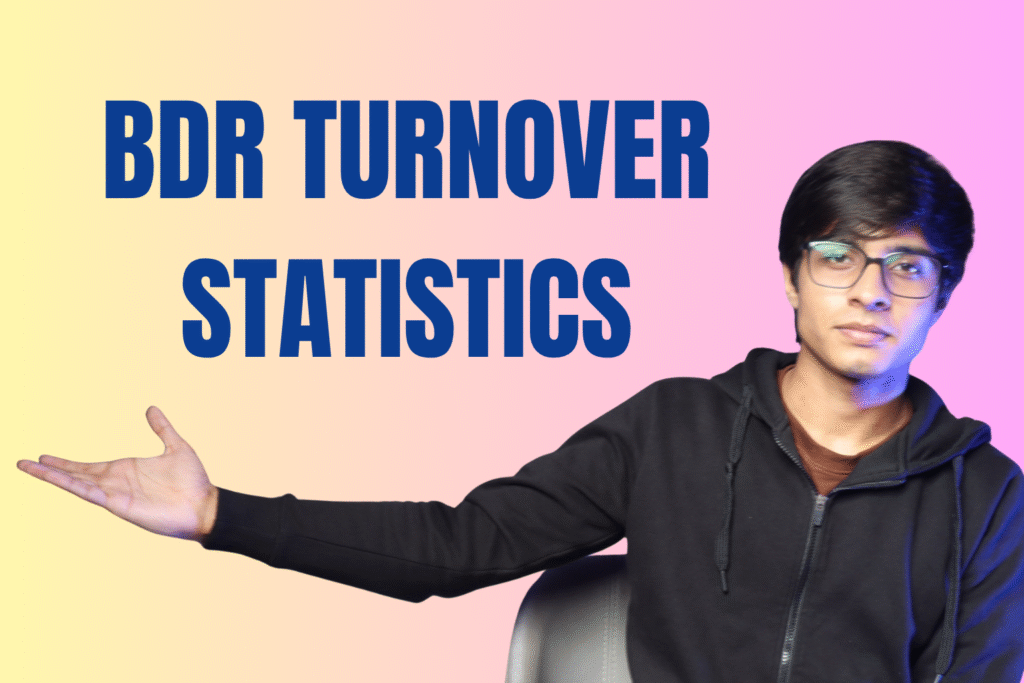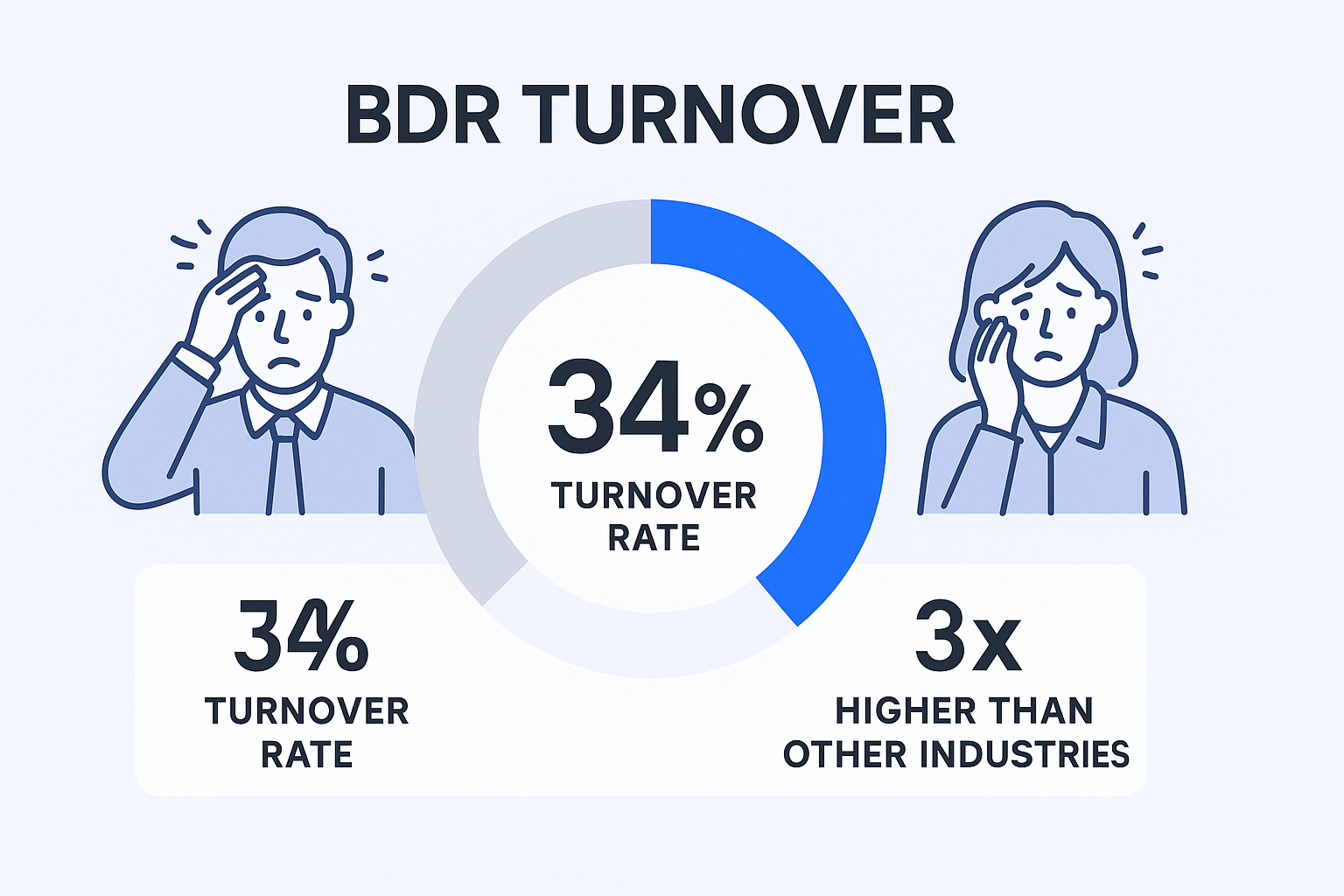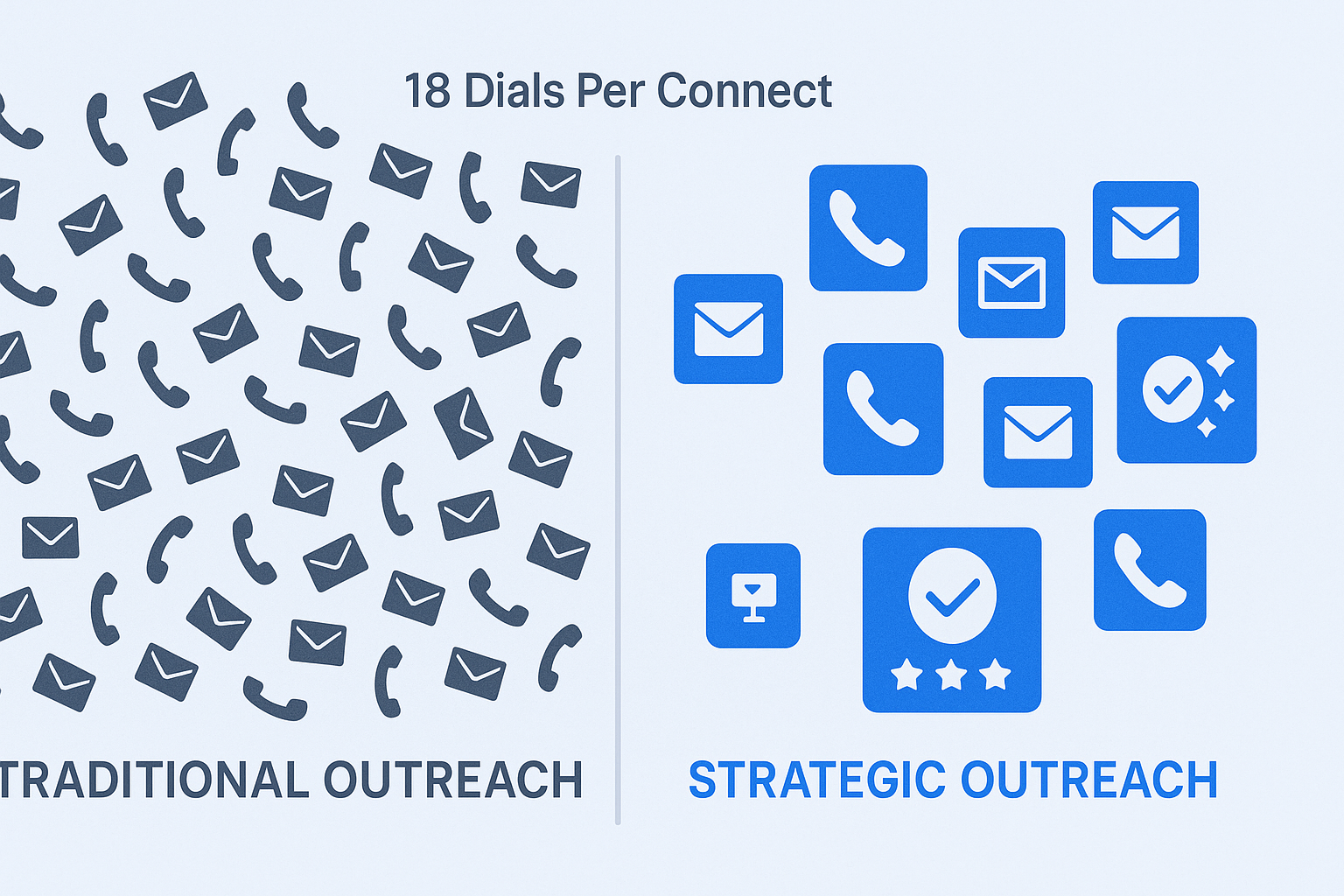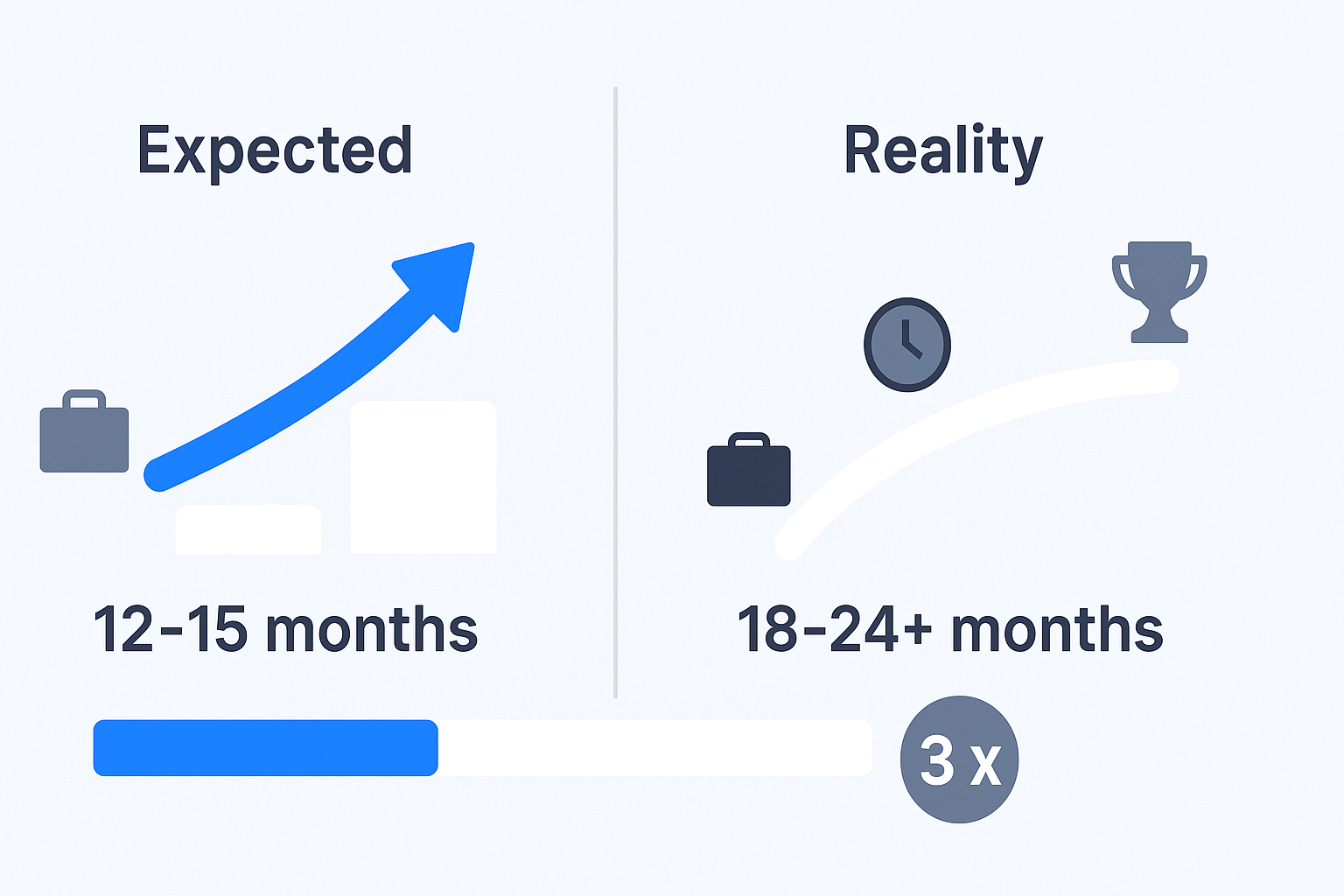- blog
- Statistics
- BDR Turnover Statistics 2025: The Truth About Retention

The Unfiltered Truth About Sales Development Turnover in 2025 (And What It Means for Your Career)
Table of Contents
The Unfiltered Truth About Sales Development Turnover in
- Average tenure in sales development sits at just 14-18 months, with most viewing it as a temporary stepping stone
- Turnover rates hitting a staggering 34%—triple the rate of other industries combined in sales development roles
- More than 1 in 10 companies see turnover exceeding 55%, showing extreme retention challenges in some organizations
- 36% of B2B companies have cut their sales development headcount, building smaller, AI-powered teams instead of large teams
- Performance metrics remain steady at around 88% quota attainment, showing turnover isn’t due to failure but unsustainability
- 80% of sales development teams report to the Sales department, up from just 60% in 2022
- 85% perform mostly or entirely outbound motions, making the role primarily about cold outreach and rejection
- Industry standard ratio is approximately 1 sales development rep for every 2.4 to 2.6 closers, creating significant pressure
- 35% to 39% of companies raised their quotas in the last year, requiring reps to run faster just to stay in place
- It takes an average of 18 or more dials just to connect with a single prospect in modern outbound calling
- Reps are expected to make 40-50 calls and send 40-100 emails every single day to hit quotas
- 90% of top performers use multi-threading strategy in 2025, up from 83% the previous year
- Median tenure of 14-18 months is by design, with new hires expecting promotion within 12-24 months
- Promised 12-15 month promotion track is being quietly extended to 18 months, 24 months, or even longer
- 65.4% view AI tools as a way to become more productive, while only 8.9% see them as a threat to their role
Excellent! I’ve now extracted statistics from 30 comprehensive articles from the SalesSo blog. Would you like me to:
- Continue with more articles if you have additional URLs
- Create a master compilation of all statistics organized by topic/category
- Create a summary document showing only the most impactful statistics across all articles
Quick Read Summary
The numbers don’t lie, and they’re not pretty. Average tenure in sales development sits at just 14-18 months, with turnover rates hitting a staggering 34%—triple the rate of other industries combined. More than 1 in 10 companies see turnover exceeding 55%.

Here’s what’s driving people out: stalled career paths where that promised promotion keeps getting pushed back, burnout from relentless high-pressure work, and compensation that doesn’t match the grind. Meanwhile, 36% of B2B companies have cut their sales development headcount, not because the role is dying, but because they’re building smaller, AI-powered teams focused on quality over quantity.
If you’re in this role, success in 2025 demands a mindset shift. You need strategic, high-quality outreach instead of spray-and-pray volume. You need to embrace AI tools to multiply your efficiency. And most importantly, you need to take control of your career path before someone else decides it for you.
Summary of Findings
Sales development sits at a critical inflection point right now. If you’re feeling the pressure, the data backs you up completely.
Performance metrics remain steady at around 88% quota attainment, but the ground is shifting beneath everyone’s feet. On one hand, 58% of teams expanded over the past year. On the other hand, economic pressure and AI-driven efficiency have led 36% of B2B SaaS companies to downsize their headcount in this exact role.
This report breaks down what these conflicting statistics mean for your job security, your next promotion, and your sanity. We’re not here to sugarcoat anything—we’re here to give you the unvarnished truth so you can navigate what’s coming.
About This Report
This isn’t another opinion piece written by someone who’s never made a cold call in their life.
This analysis synthesizes the most current and respected industry research from sources like The Bridge Group’s 2025 Sales Development Report, 6sense’s 2025 Benchmark Study, and SaaStr’s analysis of Emergence Capital data. We’ve connected the dots to give you—the person on the front lines—the truth about the state of your profession.
Introduction: Feeling the Burnout? You’re Not Alone
It’s 4 PM on a Tuesday.
You’ve made 40 dials. Sent 60 emails. Faced a dozen rejections. You’re hitting your numbers, but you can’t shake the feeling that you’re on a treadmill to nowhere.
If that sounds familiar, you’re not imagining it. The data confirms that sales development is one of the most demanding and high-churn positions in the modern workforce.
The constant pressure to hit ever-increasing quotas, the sting of daily rejection, and the nagging question of “What’s next?” are taking a real toll. But this article isn’t a list of scary statistics designed to discourage you. It’s a strategic guide to help you understand the forces shaping your career—from performance pressures to the rise of AI—so you can navigate the path forward with confidence.
The Scope of the Role: A Foundation Under Pressure
To understand why turnover is so high, we first need to look at the reality of the job itself.
The role has become the primary engine for pipeline creation, but that engine is under immense strain. The data reveals a clear contradiction: while many companies are still in growth mode (58% of teams expanding over the past year), a significant and growing segment is making strategic cuts. A landmark 2025 survey found that 36% of B2B companies decreased headcount, the highest percentage of any sales role.
This creates a volatile and uncertain environment.
This isn’t a universal trend but a strategic split. The market is dividing into two camps: companies that “scale with bodies” by hiring more reps, and companies that “scale with tech” by investing in AI to make smaller teams more efficient. The stability of your job is now directly tied to your company’s technology strategy.
The Nature of the Work
The role is overwhelmingly an outbound, sales-aligned function. In 2025, 80% report to the Sales department, a steady increase from just 60% in 2022. Furthermore, 85% perform mostly or entirely outbound motions. At its core, the job is about cold outreach—an activity defined by high rejection rates and the potential for rapid burnout.
This pressure is amplified by team structure. The industry standard ratio has held firm at approximately 1 rep for every 2.4 to 2.6 closers. This means you, as a single person, are often responsible for keeping the calendars of two or three closers full, making your performance a critical bottleneck for the entire sales team.
Performance: The Relentless Treadmill of Quotas and Dials
Here’s the paradox: turnover is incredibly high, but it’s not because people are failing.
In fact, reps are consistently achieving an average of 88% of their quota. This is crucial. The churn isn’t happening because people can’t do the job; it’s happening because the job itself is becoming unsustainable, even for top performers.
Despite this strong performance, the pressure keeps mounting. In the last year alone, 35% to 39% of companies raised their quotas. This creates a scenario where you have to run faster every quarter just to stay in the same place. The reward for hitting your number is often just a bigger number next month—a classic recipe for burnout.
The Volume Reality
The sheer effort required to hit these rising targets is immense. Research shows it takes an average of 18 or more dials just to connect with a single prospect. To achieve this, reps are often expected to make 40-50 calls and send 40-100 emails every single day.

💡 18 Dials Per Connect?
LinkedIn targeting finds decision-makers faster than traditional cold outreach ever could
This high-volume, low-yield reality is a primary source of the emotional fatigue and frustration that defines the role.
In response, top performers are shifting from pure quantity to strategic quality. The most successful professionals are now heavily engaged in “multi-threading”—building relationships with multiple stakeholders inside a target account. In 2025, 90% report using this more sophisticated strategy, up from 83% the previous year, indicating that brute force alone is no longer enough to succeed.
This dynamic creates a vicious cycle: perform well, leadership raises quotas. To meet higher quotas, increase volume of repetitive, low-success-rate activities. This leads directly to burnout, which drives even high-performing people to leave. The problem isn’t the people; it’s the design of the role.
How People Perceive Their Role: The Career Path Conundrum
At its heart, the role is sold as a short-term grind for a long-term reward.
It’s a temporary stepping stone, an apprenticeship for a lucrative career as a closer. This promise is the foundation of the entire career path. The median tenure sits at just 14 to 18 months. This isn’t an accident; it’s by design. New hires enter with a clear expectation of being promoted within 12 to 24 months.

However, that light at the end of the tunnel is getting further away.
A growing chorus reports that the promised 12-15 month promotion track is being quietly extended to 18 months, 24 months, or even longer. This is arguably the single biggest driver of voluntary turnover. When the promotion doesn’t materialize on schedule, the psychological contract is broken.
Why People Leave
The reasons are remarkably consistent across the industry:
Driver | Supporting Data |
Stalled Career Progression | The promised 12-15 month path is being extended to 18-24+ months, leading to frustration and attrition |
Burnout & High Stress | The role is defined by repetitive, high-volume tasks with low success rates (18+ dials per connect), causing emotional exhaustion |
Insufficient Compensation | Aggressive pay curves and a lack of recognition for the difficulty of the role make the grind feel unrewarding |
Lack of Effective Coaching | While 94% of managers claim they coach regularly, 53% of reps report receiving it only quarterly or less |
This isn’t just about impatience. Companies recruit ambitious, goal-oriented people by selling them a clear, time-bound career path. People accept the high-stress, low-glory nature of the job based on this promise. When the company fails to deliver that promotion on time, it’s seen as a breach of contract. The person, having hit their targets and fulfilled their end of the bargain, feels betrayed and starts looking for an external role—the very one they were promised internally.
📈 Scale Without the Stress
Our LinkedIn outbound engine delivers qualified leads through complete campaign design
Artificial Intelligence: Evolution, Not Extinction
No conversation about the future of sales is complete without addressing AI.
The good news? The narrative of “robots are coming for your job” is largely hype. The reality is far more nuanced and, for the savvy professional, full of opportunity.
First and foremost, people on the front lines are not afraid of AI. A 2024 survey found that 65.4% view AI tools as a way to become more productive, while only 8.9% see them as a genuine threat to their role. This shows that people are practical and ready to adopt tools that make their difficult jobs easier.
The Great Downsizing, Explained
The “Great Downsizing,” where 36% of companies cut headcount, is real but widely misunderstood. These companies are not eliminating the sales development function. Instead, they are using AI to shift from a “quantity” model that required large teams for spray-and-pray outreach to a “quality” model that relies on smaller, more skilled, AI-augmented teams.
However, AI adoption is still inconsistent. While the potential is clear, only about 60% of organizations have adopted at least one AI tool for their business development team. A revealing study from Salesloft found an even larger gap in practical application: only 6% use AI for task prioritization, with the vast majority still relying on gut feel and personal judgment.
🚀 LinkedIn Outbound Done Right
We design AI-powered campaigns that hit decision-makers without the burnout
The Efficiency Dividend
The primary, undisputed benefit of AI today is efficiency. A HubSpot report found that AI tools are saving sales professionals an average of 2 hours per day. This is time that can be reallocated from mind-numbing administrative tasks to high-value activities like deep prospect research and building genuine human connections.
This leads to a critical new reality: the performance gap of the future will be an AI skill gap. As companies continue to invest in technology to create leaner, more efficient teams, the professionals who remain will be expected to be more strategic. The new differentiator won’t be who can make the most calls, but who can best leverage AI to identify intent signals, personalize outreach at scale, and focus their energy on the accounts most likely to close.
“AI literacy” is no longer a bonus; it’s becoming a core competency for survival and advancement in the role.
Implications for 2025: How to Survive and Thrive
So, what does all this mean for you?
The role isn’t dying, but the “traditional” professional who just smiles and dials is an endangered species. The future belongs to the strategic, tech-savvy, and adaptable person who understands these trends and uses them to their advantage.
Here is your survival guide:
Shift from Volume to Value
The data shows a clear and irreversible trend away from spray-and-pray. Your success and job security will depend on the quality of your outreach, not the quantity. Focus your time on deep research, multi-threading within key accounts, and crafting hyper-personalized messages that demonstrate you’ve done your homework.
Become an AI Power User
Don’t wait for your manager to train you. Proactively learn and master the AI tools your company provides. Use them to automate repetitive tasks, save hours each day, and surface the data that will help you focus your efforts on the highest-intent leads. This is your new competitive advantage and your best defense against future headcount reductions.
Proactively Manage Your Career Path
The 15-month promotion is no longer a guarantee. You must become the CEO of your own career. Have explicit, documented conversations with your manager about career progression from day one. Relentlessly track your metrics and build a data-driven business case for your promotion. If your company isn’t transparent or supportive of your growth, don’t be afraid to take your proven skills to a company that is.
🎯 Skip the BDR Grind
Build your pipeline through LinkedIn targeting, not 50 daily cold calls
7-day Free Trial |No Credit Card Needed.
Develop “Closer” Skills Now
The line between top-tier sales development and junior closing roles is blurring. The most valuable professionals are already developing skills in consultative selling, advanced discovery, and strategic objection handling. Shadow your closers, listen to their calls, and ask for coaching. Start thinking and acting like a closer long before you have the title.
Build Your Tech Stack with Salesso
Here’s something most people overlook: your email infrastructure can make or break your outreach success. When you’re sending high volumes of cold emails, deliverability is everything. One spam flag, and your entire domain reputation tanks.
Salesso solves this by providing verified cold email addresses that keep your primary domain clean and your deliverability rates high. Instead of risking your company’s main email infrastructure, you can use dedicated addresses specifically designed for outbound prospecting.
Think of it this way: you’re already working on quality over quantity in your messaging. Salesso helps you maintain that quality at the infrastructure level, ensuring your carefully crafted outreach actually reaches inboxes instead of spam folders.
It’s the same approach top performers use—separating cold outreach from your primary email to protect your sender reputation and maximize response rates. In a world where 36% of companies are cutting headcount, being the person who consistently hits inbox and generates replies is what keeps you valuable.
Career Snapshot: Key Statistics for 2025
Metric | Benchmark |
Median Tenure | 14-18 months |
Average Quota Attainment | 68-88% |
Median On-Target Earnings (OTE) | $80,000 |
Expected Promotion Timeline | 18-24 months (up from 12-15) |
Annual Turnover Rate | ~34% |
Survey Sample
This analysis is based on findings from leading industry reports published in 2024 and 2025, including The Bridge Group’s biennial Sales Development Report, 6sense’s Science of B2B Benchmark, HubSpot’s Sales Trends Report, and SaaStr’s analysis of the Emergence Capital ‘Beyond Benchmarks’ survey.
Collectively, these reports survey hundreds of B2B companies and thousands of sales professionals, providing a comprehensive and data-backed view of the current landscape.
Conclusion
The sales development role in 2025 is not for the faint of heart.
With 34% annual turnover, extended promotion timelines, and 36% of companies cutting headcount, the old playbook of “just work harder” no longer applies. The professionals who will thrive are those who embrace strategic outreach, master AI tools, and proactively manage their career progression.
The data tells a clear story: the role is evolving from high-volume to high-value. Companies want smaller teams of highly skilled professionals who can leverage technology to punch above their weight class. If you’re willing to adapt, there’s never been a better time to separate yourself from the pack.
Take control of your career path. Invest in your AI literacy. Focus on quality over quantity. And remember—the best time to start looking for your next opportunity is when you don’t need to.
The future belongs to those who see these changes coming and position themselves accordingly. Make sure you’re one of them.

Escape the BDR Burnout Cycle
Let LinkedIn outbound replace cold calling chaos with qualified meetings
Segmentation That Actually Converts
LinkedIn outbound targets precise demographics with strategic campaign design and scaling methods

